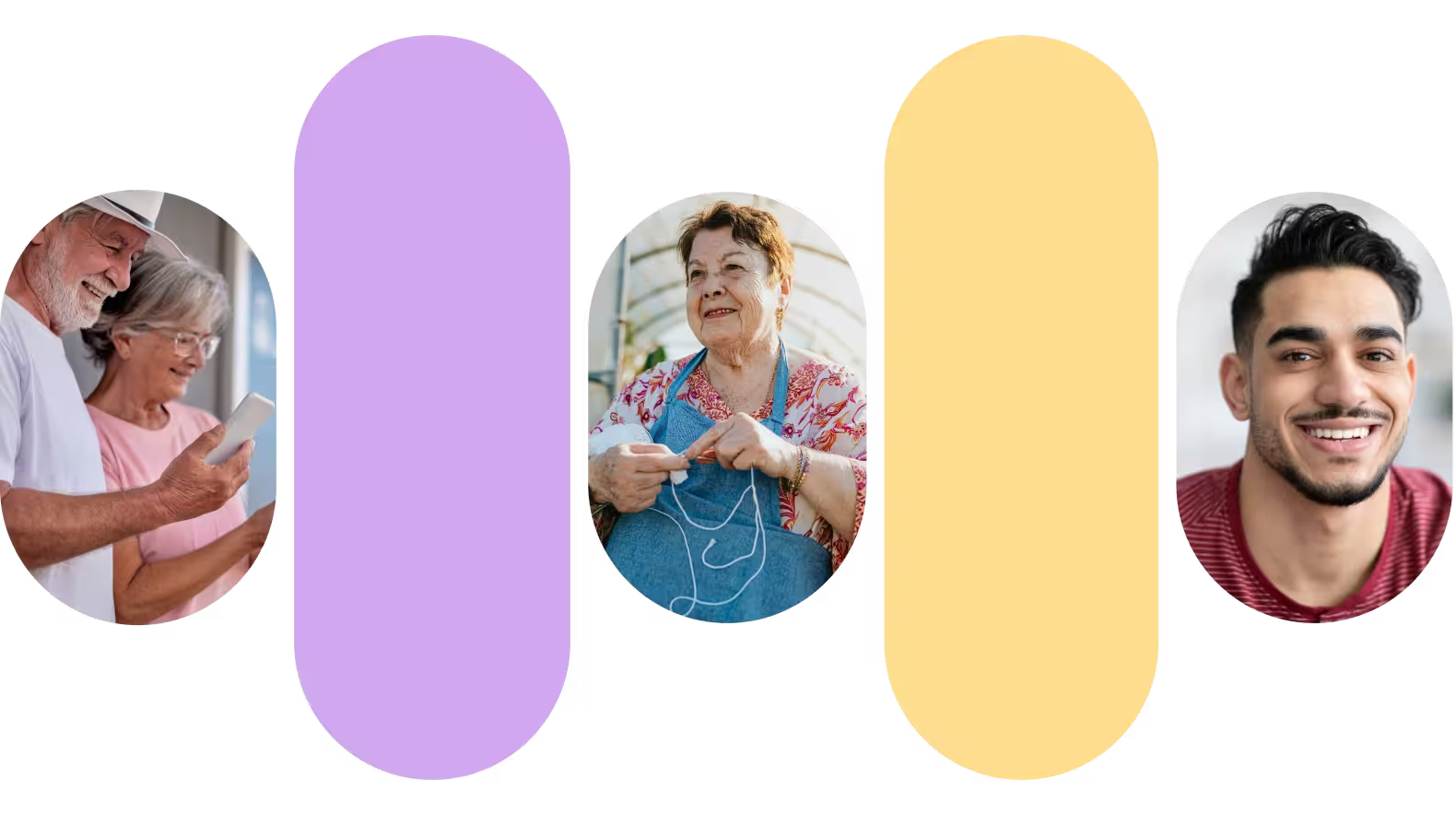Free Equipment Options for Deaf and Hard of Hearing Individuals in the US
Learn about free equipment and services you can access as a deaf or HoH individual living in the US. Find more about it right here!

From working from home to forming social connections, our world heavily relies on telecommunications. For the deaf or hard of hearing community, this involves seeking and acquiring the right assistive technology, such as captioned telephones, video relay services, or text-based communication devices, to access information, connect with others, and thrive in both personal and professional spheres.
If you
Fortunately, there’s free equipment options for deaf and hard of hearing individuals that can make a real difference in your life and go beyond your typical "free" stuff. These resources are high quality, so you don't have to settle for anything less.
Intrigued yet?
Let's explore a few free equipment options for deaf and hard of hearing people and shed light on important industry terminologies such as TRS, VRS, CTS, TTY, RTT, and Relay.
Breaking Down Industry Terminology
The industry terminology associated with these services may initially seem overwhelming, but understanding them is crucial to accessing the right equipment. So, before we dive into free equipment options for deaf and hard of hearing, we'll help you familiarize yourself with the following industry terminologies:
- TRS (Telecommunications Relay Service): TRS is a service that allows individuals who are deaf or hard of hearing to communicate over the telephone network by using a relay operator or modern technologies.
- VRS (Video Relay Service): VRS enables deaf and hard of hearing individuals to communicate via sign language using video telephones or video conferencing. Sign language interpreters assist in relaying the conversation.
- CTS (Captioned Telephone Service): CTS displays written captions of the spoken conversation in real-time.
- TTY (Teletypewriter): TTY devices, also known as text telephones or TDDs (Telecommunication Devices for the Deaf), are telephone equipment for the deaf that allow typing and reading text-based messages over the telephone network.
- RTT (Real-Time Text): RTT is a modern alternative to TTY that supports real-time text communication without the need for special equipment for deaf people, utilizing smartphones, computers, or other devices.
- Relay: Relay refers to the overall system and services that enable communication between deaf or hard of hearing individuals and those without. It encompasses various relay services, such as TRS, VRS, CTS, TTY, and RTT.
Free Equipment Options for Deaf and Hard of Hearing That You Just Can’t Miss
1. Nagish
Nagish is a free app that captions phone calls using AI, converting text-to-speech and speech-to-text in real time. You can download Nagish for free without proof of eligibility. The app can be used as free equipment options for deaf and hard of hearing to easily communicate and interact with the world.Features:
- 100% private - no interpreter needed!
- When you use Nagish for a phone call, the other side of the call hears a natural-sounding voice, and whatever they say is shown as text on your screen.
- The person on the other end of the phone doesn’t need the app installed.
- Keep your existing phone number
- You can save your call transcripts
- You can log your call history
- Type to speak or use your voice.
- Read captions, or hear the other side in real-time.
- Made by and for people who are deaf/hard of hearing.
- Supports English, French, Japanese, Italian, and Hebrew
- Available for iOS and Android devices
2. iCanConnect
iCanConnect provides free equipment options and training for people with significant hearing and vision loss who meet the program’s disability and income eligibility guidelines.
Features:
- Free for eligible individuals
- Equipment and technology span from specialized keyboards, computers, smartphones, and more.
- In addition to the equipment, they also provide training
3. The Telecommunications Equipment Distribution Program (TEDP)
This program aims to equip eligible participants with the necessary telecommunications equipment, services, and training to improve their communication experience. They provide telephone equipment for the deaf and hard of hearing and equipment options for deaf children.
Features:
- Some of the equipment commonly provided includes amplified telephones, Voice Carry Over (VCO), captioned telephones, TTY phones with braille and large-print displays, hands-free speaker telephones, auto-dialers, ring signalers, and more.
- They also offer specialized and in-home training: TEDPs often offer training programs to familiarize individuals with the equipment and ensure its effective use in daily communication.
4. Caption Phone
Although landlines are in decline, they are still a viable option. A caption phone transcribes live phone conversations so it appears in easy-to-read text on a large screen.
Captioned phones are deaf equipment for home that is provided for free to qualifying individuals through a program funded by the FCC called the Intrastate Telecommunications Relay Services program.
Several participating phone companies provide captioned phones, such as CapTel, CaptionCall, and ClearCaptions.
Features:
- Captioned telephones are readily available, relatively inexpensive or free for eligible individuals, easy to use and can be used with hearing aids or without.
- Some captioned telephone providers offer free delivery as well as installation, set-up and user training at no charge.
- Under FCC regulations, captioned providers are not allowed to store call content.
5. InnoCaption
InnoCaption is free equipment options for the deaf or hard of hearing that offers real-time captioning to facilitate phone calls. Eligible users in the United States can use the InnoCaption app at no cost because they are funded by the FCC's Telecommunications Relay Services Fund.
Features:
- Make voice calls and read captions from the other party
- Provides contact syncing and call transcripts
- DeskView feature allows users to see captions on a computer screen
- Reads voicemail
- No need to make calls through a relay center
- Supports English and Spanish
- Available for iOS and Android devices
6. Sorenson Video Relay Services
through sign language using video phones or video conferencing. It offers qualified users the ability to make video calls with sign language interpreters.
Features:
- Uses visual sign language via video phones or video conferencing.
- Qualified users have access to sign language interpreters for video calls.
7. Purple Communications
Purple Communications provides a variety of services, including video relay services, text relay services, and on-site interpreting.
Features:
- Offers video relay services, text relay services, and on-site interpreting.
- Provides a range of communication services to meet diverse needs.
- Support for both video and text-based communication methods.
8. Hearing Loss Association of America (HLAA) Scholarships and Grants
The Hearing Loss Association of America (HLAA) offers scholarships and grants for individuals with hearing loss to access free or discounted hearing equipment and assistive technology. HLAA partners with various organizations and technology providers to offer a range of assistive devices, including hearing aids, alerting devices, and amplification equipment, depending on the grant's specifics.How to Access for Free:
- Eligibility: Eligibility criteria vary by grant or scholarship, but most are open to U.S. residents with significant hearing loss who demonstrate financial need.
- Application Process: To apply, visit the HLAA website and explore their resources section for current grant or scholarship offerings. Applications typically require documentation of hearing loss, proof of income, and a statement of need.
Features:
- Grants and scholarships for hearing aids, alerting devices, and other assistive technologies
- Free or reduced-cost equipment provided through HLAA partnerships
- HLAA also offers support and resources for ongoing hearing assistance and training
9. Audient Alliance
The Audient Alliance is a national nonprofit program that provides access to free or discounted hearing aids and amplification devices to individuals in need. Managed by the EPIC Hearing Healthcare Alliance, this program works with hearing health professionals to offer hearing aids at significantly reduced or free rates for qualifying individuals.How to Access for Free:
- Eligibility: Audient is available to low-income individuals with documented hearing loss. Eligibility is based on income, and applicants must meet the financial criteria set by Audient.
- Application Process: To apply, individuals can complete an online application on the Audient Alliance website. Once qualified, Audient will connect users with local hearing professionals for fitting and equipment setup.
Features:
- Free or heavily discounted hearing aids and assistive listening devices
- Partner network of audiologists for fitting and support
- Application assistance and eligibility counseling available through Audient
How to Qualify for Free Equipment Programs
Obtaining free equipment as a deaf or hard of hearing individual is often possible through government or nonprofit programs, each with its own set of eligibility criteria.
Here’s a guide to the common requirements and application processes for some popular programs.
Common Eligibility Requirements
While eligibility criteria vary by program, the following are commonly required:
- Degree of Hearing Loss or Disability: Most programs require applicants to provide proof of significant hearing loss, which may include a documented diagnosis from a licensed hearing professional.
- Income Limits: Some programs, especially those funded through government sources, may have income restrictions to ensure the services are provided to those most in need. For instance, applicants may need to demonstrate income below a certain threshold or provide proof of receiving other forms of assistance.
- Residency: Many programs, particularly state-run services, require applicants to be legal residents of the state in which they’re applying. Proof of residency, such as a state ID or utility bill, is typically needed.
- Age or Dual Disability Requirements: Certain programs, like iCanConnect, also serve individuals with both hearing and vision loss. Age requirements may also apply, depending on the program.
Conclusion
The availability of free equipment options for deaf and hard of hearing individuals in the US is a game-changer. These resources go beyond the typical notion of "free" and offer high-quality assistive technology that bridges the communication gap and makes a real difference in the lives of individuals.
Thanks to technological advancements, free apps like Nagish are constantly evolving to provide the best experience in real-time captioning and communication assistance to those who need it most for free.
Additionally, captioned telephones, such as CapTel, CaptionCall, and ClearCaptions, are readily available and can greatly enhance communication.
With the increasing user-friendliness and privacy of relay services and assistive technologies, the deaf and hard of hearing community can now thrive in personal and professional areas with greater ease and accessibility.














